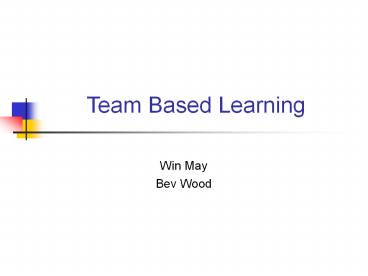Team Based Learning - PowerPoint PPT Presentation
Title:
Team Based Learning
Description:
Team Based Learning Win May Bev Wood What? Instructional strategy based on procedures for developing high performance learning teams Michaelsen, Knight & Fink, 2002 ... – PowerPoint PPT presentation
Number of Views:226
Avg rating:3.0/5.0
Title: Team Based Learning
1
Team Based Learning
- Win May
- Bev Wood
2
What?
- Instructional strategy based on procedures for
developing high performance learning teams - Michaelsen, Knight Fink, 2002
3
Teams are distinct from groupsand more powerful
- A group is not a team
- Commitment to the goals and welfare of the group
a team - Cohesive teams can do things that an individual
or a new group cannot - Team-based learning starts with groups and
creates teams
4
Why?
- Enhances problem-solving skills
- Replaces or reduces lecture time
- Creates energy in the classroom
- Promotes team work
- Ensures that students are prepared and on time to
class
5
Team learning nurtures the development of high
levels of group cohesiveness
6
Special characteristics of teams
- High level of commitment to the group
- High level of trust among members
- Long term instruction with a series of
independent learning activities
7
Essential principles of team based learning
- 1. Groups properly formed and managed
- Minimize barriers
- Member assets
- Large and diverse
- Permanent
8
Essential principles of team based learning
- 2. Students must be made accountable
- Pre class preparation
- Contributing
- High quality performance
- Grading
9
Essential principles of team based learning
- 3. Team assignments must promote learning team
development
- Appropriate
- Require team interaction
10
Essential principles of team based learning
- 4. Students must receive frequent and immediate
feedback
- Timely (Readiness
- assessment tests)
- Timely on application-focused assignments
- Assignments require the right output from teams
- Teams assess and provide own feedback.
11
How?
- Students acquire initial exposure to the content
through readings. - Held accountable for their preparation using a
Readiness Assurance Process (RAP). - Following the RAP, they collaborate on in-class
application assignments.
12
Instructional Sequence in TBL
- 3 Phases
- Reading Preparation (pre-class)
- Readiness Assurance Process
- In-class Application Exercises
13
What is RAP?
- RAP occurs at the beginning of each major
instructional unit. - It ensures that students have completed pre-class
reading assignments and are prepared for in-class
team work.
14
RAP - How?
- The process consists of a multiple choice test
(15-20 questions) on key concepts from the
readings. - It is first taken individually and then
immediately re-taken as a team. - RAP typically consists of five elements
- 1. Assigned Readings
- 2. Individual Testing and Feedback (Scantron)
- 3. Team Testing and Feedback (IF-AT sheets)
- 4. Discussions and Appeals
- 5. Mini-lecture/Instructor Feedback
15
In-class Exercise
- 3 Ss
- Same Problem. Groups work on the same problem,
case or question. - Specific Choice. Groups must know and use course
concepts to make a specific choice. - Simultaneous Report. Groups report their choices
simultaneously. - This stimulates an energetic total-class
discussion with groups defending their answers
and the teacher helping to consolidate learning.
16
Instructional Activity Sequence
Preparation Pre class
Readiness Assurance Diagnosis-Feedback
Application of Course content
5 Instructor feedback
6 Application oriented activities
1 Individual study
4 Written appeals
3 Team test
2 Individual test
17
Principles of Active Learning
- Individual and group accountability
- Need and opportunity for group interaction
- Motivation to engage in give-and-take discussion
18
Paradigm Shifts in TBL
- Primary learning objectives shift from knowing to
using and applying the course concepts. - Role and function of the teacher shifts from a
sage on the stage to a guide on the side. - Role and function of students shifts from being
passive recipients of information to being active
acquirers of information and applying the
information in a variety of contexts and to a
variety of problems.































